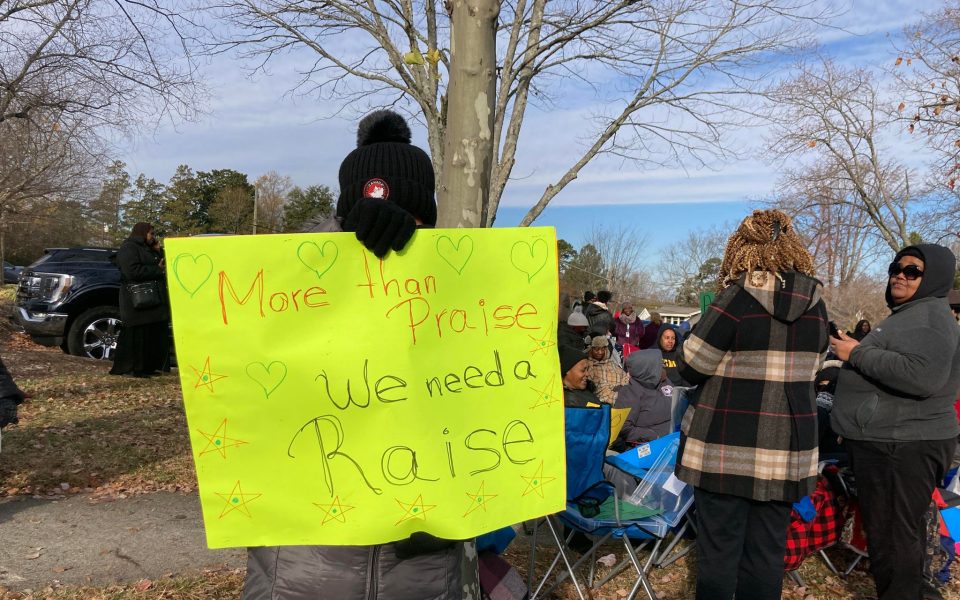Featured photo: Guilford County Schools cafeteria workers hold up signs during their second day of protest on Nov. 28. (photo by Sayaka Matsuoka)
Guilford County Schools’ cafeteria workers will return to schools on Wednesday.
During a press conference on Tuesday evening, Superintendent Whitney Oakley told reporters that she met with about 60-100 employees at a town hall to listen to their concerns.
“We did receive confirmation that school nutrition workers do plan to return to work tomorrow, November 29,” she said. “We are really grateful to our hardworking employees for their decision to return. We know they share our commitment to students’ well-being and we do look forward to continuing to serve students together.”

The return to schools comes after two days in which close to 200 cafeteria employees from across Guilford County went on strike this week for higher wages. On Tuesday afternoon, the district unveiled an updated pay plan that includes a 4 percent raise for assistant cafeteria workers and a 7 percent raise for cafeteria managers. The plan also includes a quarterly bonus for managers who serve on average, at least 100 meals per day.
In addition to the announced raises, the district also said that it would implement an advisory council for school nutrition employees to foster ongoing discussions and feedback moving forward. Oakley said that they plan on having the council formed by the end of January 2024.
Kelly Shepherd, Eastern High School’s cafeteria manager who helped organize the strike this week, said on Tuesday evening that the workers didn’t get everything that they asked for but that they still consider this week’s efforts a win.
“We felt like we were at a position where we didn’t get everything we wanted but we did get something accomplished with the percentages and stuff that we got and we laid groundwork, we think, for budget negotiations come spring,” Shepherd. “I think we can call it a win. Did we get everything? Absolutely not.”

One of the things that he and many other employees are still hoping for is the reinstitution of the “step” payment plan, or a pay scale in which workers are paid based on years of experience.
During Monday’s press conference, Oakley mentioned that while they can’t guarantee that the “step” pay would come back, but that now is the time to think about it as they plan for the next budget cycle.
When asked why the “step” pay was eliminated a few years ago, Oakley said that when the state raised the minimum pay for cafeteria workers to $15 per hour, it made the step pay unsustainable.
“There were people making $12 an hour and then the minimum was raised, that creates that compression if you think about it in terms of how much people make and years of experience,” Oakley said. “But we have gone back and figured out how to do that in other areas. This is different because of the fact that it’s an enterprise fund; it’s not state or locally funded source so we are committing to having a conversation and figuring out how to do that, but it’s going to have to be different than what we do for our bus drivers, or our plumbers, or our grounds crew just because of how school nutrition is funded. But we did tell them in writing and tonight and yesterday that we hear them and that step is a concern.”
Oakley said that during the town hall she met with two cafeteria managers, one who has been working for 23 years and one who had been working for two weeks. Their pay is the same.
“That doesn’t feel fair no matter what your job is or what industry you’re in,” Oakley said. “We are committed to having that conversation. I also think we have to understand how the funding stream works and that’s the reality.”

Going into the future, Oakley said that because nutrition workers aren’t funded by the state, the school district will have be creative about pooling funding from different pots including federal, state and local funding for not just cafeteria employees, but all employees.
Part of making it easier to fund public schools and thus pay employees, is electing the right officials, something Oakley alluded to during Monday’s press conference.
“I don’t want to say that this is it and we’re done but it’s something that we have to work on and work towards,” Oakley said. “We can’t do that as a school district alone though. People have to think about who they vote for, how they vote, where they show up, who they advocate for. And we need to make sure that the choices we’re making are in favor of public education.”
As reported by Education NC, NC has been ranked last in the nation for K-12 public school funding in recent years. According to data collected by the Education Law Center, NC’s per-student funding, funding distribution between low-poverty and high-poverty districts, as well as the amount of the state’s GDP that is dedicated to funding schools, resulted in the state ranking last in a 2022 report.
At the end of September, GOP lawmakers pushed to include an expansion of the school voucher program into the state budget, which passed without Gov. Roy Cooper’s signature.
Many Democratic representatives, including Rep. Ashton Clemmons and Sen. Gladys Robinson, both of Guilford County, pushed back against the expansion stating that it takes funding away from public schools.
“Let me be clear: We’re using public, taxpayers’ money to subsidize private schools for wealthy people, and that’s not because they asked for it, it’s simply because you want to give it to them,” Robinson said in a NC Newsline article.

And that’s as funding for public schools has gone down when calculated on a per-student basis.
A report by Education NC also showed that despite cafeteria workers’ concerns this week, Guilford County actually ranks in the top third for funding when compared to the other 99 counties in the state.
According to the report, Guilford County ranked No. 14 in terms of funding effort in 2023 and No. 12 in base local appropriations rank. The county ranked No. 33 in ability to pay which is measured by “a county’s per student fiscal capacity to support public schools.” The Local School Finance Study found that “large, urban counties combining high adjusted property valuations with broad-based economic activity and high per capita incomes tend to rank highest on this measure.”
In terms of property value rank, Guilford County ranked No. 46.
Currently, the county commissioners, who set the property tax rate every year, is comprised of seven Democrats and two Republicans after Republican James Upchurch vacated the District 6 seat in October. Historically, Democratic members of county commission have been more vocal about funding for public education compared to their Republican counterparts.
After the two days of striking, Shepherd said that he’s optimistic about the future.
“I’m overall please and I think the group is too,” he said. “Again, not exactly what we wanted but better than what we thought going in. And, not having been a budget negotiator, I don’t think we did too bad. We hadn’t gotten fired yet so that’s a win, right?”
Join the First Amendment Society, a membership that goes directly to funding TCB‘s newsroom.
We believe that reporting can save the world.
The TCB First Amendment Society recognizes the vital role of a free, unfettered press with a bundling of local experiences designed to build community, and unique engagements with our newsroom that will help you understand, and shape, local journalism’s critical role in uplifting the people in our cities.
All revenue goes directly into the newsroom as reporters’ salaries and freelance commissions.


Leave a Reply